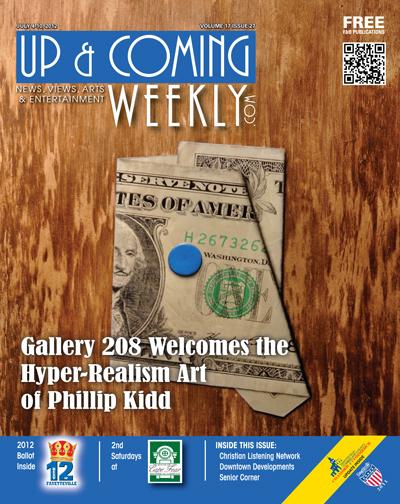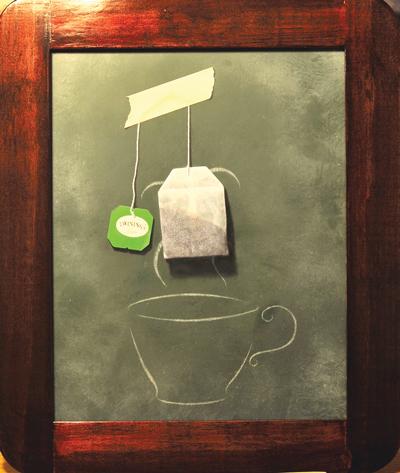 Visitors to Gallery 208 will be nothing short of astonished. While viewing the
oil paintings by Phillip Kidd, you are going to have to control your impulse to
peel the tape off the surface of one of Kidd’s oil paintings. You’re going to feel
confi dent that a card from the game of Monopoly on the surface of a different
painting could also be removed from the painting’s surface. Then you discover
it’s all an illusion; Kidd is a painter of hyper-realism and every object in the
painting has been meticulously painted to appear as if it actually exists.
Visitors to Gallery 208 will be nothing short of astonished. While viewing the
oil paintings by Phillip Kidd, you are going to have to control your impulse to
peel the tape off the surface of one of Kidd’s oil paintings. You’re going to feel
confi dent that a card from the game of Monopoly on the surface of a different
painting could also be removed from the painting’s surface. Then you discover
it’s all an illusion; Kidd is a painter of hyper-realism and every object in the
painting has been meticulously painted to appear as if it actually exists.
Kidd’s style of hyper-realism is not something we often see in our local and regional art venues. Known as Trompe l’oeil (“fools the eye”), Kidd brings a unique sense of humor to his paintings; small in scale, his skill level is extremely high — looking at the paintings you feel comfortably uncomfortable. He stimulates our imagination and earns our respect for the talent it takes to create works in that particular genre of painting.
In one of his paintings, a crimped tube of Winsor Newton flake white oil paint is held to a vertical surface by a piece of masking tape. In another painting a Twining bag of tea is taped to a caulk board with a piece of masking tape; a line drawing of a cup is under the tea bag and appears to be drawn with chalk. Everything I have mentioned is an illusion, painted in oil.
In Kidd’s paintings the size of the object(s) is correct, he pays close attention to every minute detail; the fine distinction of light and color are skillfully incorporated to create an illusion of the threedimensional. He is part of a tradition, the pursuit of realism in art, which has dotted the western tradition, beginning with the Romans. His style is a genre that has continued to be practiced since the Renaissance. Today this style of super realism has been influenced by a modern quest — a preoccupation with perceptions in art and painting.
There is nothing traditional about the way Kidd learned to paint in this style. His father chose a career with the U.S. Air Force so the family did a great amount of traveling. While his father was stationed at Maxwell Air Force Base in Montgomery, Ala., Kidd attended high school in Montgomery. It was during his last year in high school that a field trip to an art museum infl enced his choice about his own career.
He shared the following with me: “It was during my senior year, we took a field trip to the Montgomery Museum of Fine Arts and I saw a Trompe l’oeil exhibit featuring all the best of today’s artists. I had never heard of this style and never knew people were doing this or even capable of it. It hit me that this was what I had been working towards with my pursuit to make my work look realistic.”
The problem for Kidd was that most art schools or universities do not teach the techniques he sought to learn. So, starting in high school through his education in the arts at Auburn University at Montgomery, Kidd taught himself by study, trial and error how to paint in the Trompe l’oeil style. After seeing a work by Anthony Waichulis at the Montgomery Museum exhibit, he emailed him occasionally to ask questions about techniques. Kidd noted: “I maintain this communication with Waichulis today. I am also still inspired by the old masters and the history of art.”
Kidd doesn’t use any technology in his paintings, no transfer techniques. His panels are sanded and sealed as smooth as glass before he begins painting. As Kidd says, “There are no tricks to what I’m doing; it’s just brushes in oil on panel. The ideas in my paintings are simple and sometimes comical; I paint them simply for the joy of the fi nished product.”
The Leonard McLeod Gallery is hosting a totally different type of exhibit. Original colorful drawings by Rose-Ann San Martino were created to illustrate a recent publication by Sharon Murphy Yates: The Journey from Oz: Seven Steps for Finding Your Way Back to Places You Never Intended to Be.
According to Yates, “The Journey from Oz is a simple message of hope and
encouragement for anyone confronting challenges
in life. With warmth and understanding, it offers
simple supportive advice to guide readers toward
help and healing one step at a time.”
Knowing the art work of San Martino, Yates felt
she was the perfect artist to illustrate the book.

San Martino took the challenge with confi dence and vigor and felt Yates’ writing was very visual.
San Martino noted an example: “When I read, ‘Well I’m out of bed and I have clean underwear’ on is something I can instantly visualize. As well, ‘Figure out what you need and leave the crap behind’ is another example of the visual. For me it easily translates into a suitcase and packing; but what is it in your life journey you need to leave behind — anger, an attitude of pleasing everyone, lies, — these are things that weigh you down.”
Although the book is serious and therapeutic, the combination of easy reading and the illustrations make it highly user-friendly. Yates explains: “I wrote the book for adults who might be going through diffi cult situations, but never really thought about targeting any particular age group. No matter your age, everyone can use a little guidance and encouragement at different times in their lives.”
San Martino’s illustrations reflect her fine art painting style — colorful and the use of repeating patterns to create texture, meaning and rhythm. She reflected on her illustrations by saying, “I think the illustrations reflect what is said in the book in a cheery, colorful, literal way, but they also invite you to look a bit closer. The lack of depth, bright colors and purposeful naiveté are to remind the readers of childhood illustrations they might have read, pictures they might have drawn. I think the decorative design patterns tie the illustrations together and keep the mood from being too serious.”
The project took the artist and writer three years to complete. Both had input as to the layout of the book and the details for each section. San Martino did sketches, cropped and experimented with colors; Yates was there to give her personal feedback about each sketch.
“Rose-Ann and I talked about the book and the message I wanted to convey, she read the text and then brought me ideas. She made it really easy because she had a way of taking my ideas and adding elements that made them better. Sometimes (like in the illustration about packing) she would refl ect the ideas in the text in ways I hadn’t thought about. I think that creativity added a lot to the way readers can connect with the words,” said Yates.
Visitor to the Leonard McLeod Galley at Up and Coming Weekly get to see both exhibits and will meet Phillip Kidd, Rose-Ann San Martino and Sharon Yates at the opening reception on July 12 between the hours of 5 and 7 p.m. It’s free to the public, so everyone is invited. The exhibit will remain in the galleries through late August. For information call Up and Coming Weekly at 910-484-6200.
Photo: The hyper-realism of Phillip Kidd brings a new dimension to the ordinary.